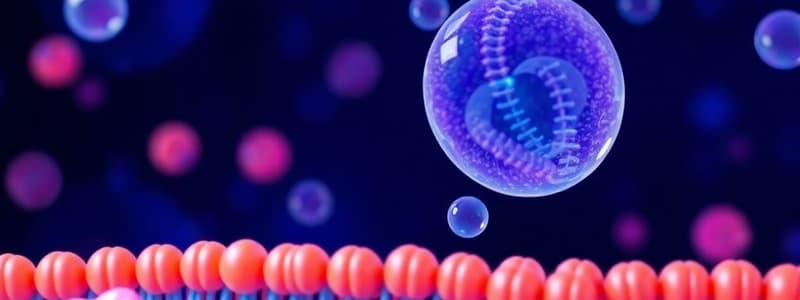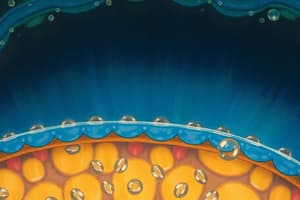Podcast
Questions and Answers
What is the primary role of cholesterol in the cell membrane?
What is the primary role of cholesterol in the cell membrane?
Integral proteins are loosely attached to the surface of the cell membrane.
Integral proteins are loosely attached to the surface of the cell membrane.
False
What term describes the arrangement of phospholipids in the cell membrane?
What term describes the arrangement of phospholipids in the cell membrane?
phospholipid bilayer
The carbohydrate molecules on the cell membrane are involved in cell-cell ______, communication, and adhesion.
The carbohydrate molecules on the cell membrane are involved in cell-cell ______, communication, and adhesion.
Signup and view all the answers
Match the following components with their functions in the cell membrane:
Match the following components with their functions in the cell membrane:
Signup and view all the answers
Which of the following describes a key feature of prokaryotic cells?
Which of the following describes a key feature of prokaryotic cells?
Signup and view all the answers
Eukaryotic cells are always smaller than prokaryotic cells.
Eukaryotic cells are always smaller than prokaryotic cells.
Signup and view all the answers
What type of cells have a rigid cell wall made of cellulose?
What type of cells have a rigid cell wall made of cellulose?
Signup and view all the answers
The __________ are specialized structures within eukaryotic cells responsible for energy production.
The __________ are specialized structures within eukaryotic cells responsible for energy production.
Signup and view all the answers
Match the following types of cells with their key features:
Match the following types of cells with their key features:
Signup and view all the answers
Study Notes
Learning Outcomes
- Learning outcomes are defined as the desired knowledge, skills, and abilities students should gain after a lesson or course.
- A clear list of learning outcomes helps guide the instruction and assessment process, ensuring that students meet desired learning goals.
- These learning outcomes are categorized by topic number and are included within the provided text.
Introduction to Physiology: Structural Organization and Transport System
- Explain the levels of organization of the human body.
- Differentiate the general cell types.
- Describe eukaryotic cell components and functions.
- Explain cell membrane structures and functions.
- Describe different cell organelles with their structures and functions.
- Explain different types of cellular transport.
Homeostasis and Body Fluid Compartments
- Define homeostasis.
- Describe the mechanisms of homeostasis with suitable examples.
- Describe the compartments of body fluid.
- Describe the constituents of body fluids.
- Discuss the functions of each body fluid compartment.
Blood and its Components
- List the different components of blood.
- Define blood components.
- Describe the functions of blood.
- List the components of plasma proteins.
- Discuss the functions of plasma proteins.
- Discuss briefly the types of hematopoiesis.
Erythropoiesis and its Control
- Define erythropoiesis.
- Describe the locations of erythropoiesis.
- Discuss different types of cells involved in erythropoiesis.
- Describe different stages of erythropoiesis.
- Describe regulation of erythropoiesis.
- Describe the abnormal morphological changes of RBC.
- Define polycythemia.
- Discuss the causes of polycythemia.
- Define anemia.
- Discuss different types of anemia.
Blood Grouping and Blood Transfusion
- Define the different types of blood groups.
- Explain the principle and methods of blood grouping.
- Define blood transfusion.
- Discuss the precautions, indications, and hazards of blood transfusion.
- Describe transfusion complications.
- Discuss different types of WBCs.
- Mention briefly the types and steps of leucopoiesis.
- Discuss morphological characteristics of WBCs.
- Describe the function of leucocytes.
- Discuss WBC proliferative disorders.
Platelets and Hemostasis
- Mention the morphological characters of platelets.
- Discuss the steps of thrombopoiesis.
- Discuss the dynamics and activation of platelets.
- Define hemostasis.
- Discuss the factors involved in blood coagulation.
- Mention the steps of blood coagulation.
- Discuss different coagulation disorders.
Lymphatic and Reticuloendothelial System
- Discuss the components of the lymphatic system.
- Describe the formation and circulation of lymph.
- Discuss the composition of lymph.
- List the functions of the lymphatic system.
- Define Reticuloendothelial (RE) system/mononuclear phagocyte system (MPS).
- Discuss the components of RE system.
- Mention the function of RE system.
Membrane Potentials
- Explain the physiological basis of resting membrane potential and its differences in different tissues.
- Describe the generation and different phases of the action potential.
Properties and types of nerve
- Discuss briefly the propagation of nerve impulse.
- Distinguish between refractory period and action potential in nerve and cardiomyocytes.
Synapses and Neuromuscular Junctions
- Define synapse.
- Describe different types of synapses.
- Describe the process of signal transmission through a chemical synapse.
- Define neuromuscular junction.
- Describe the structure of NMJ.
- Describe the signal transmission through NMJ.
Physiology of Skeletal and Cardiac Muscle Contraction
- State the locations and characteristics of different types of muscle cells.
- Explain the structure of skeletal muscle.
- Describe the skeletal muscle contraction on the basis of sliding filament model and the types of contraction.
- Describe the cardiac muscle contraction, generation of cardiac action potential and the role of junctional tissues.
- Explain the biophysical properties of skeletal muscle on the basis of length-tension relation and force-velocity relation.
- Describe the structural abnormalities in muscle mentioning hypertrophy, hyperplasia and atrophy.
Physiology of Smooth Muscle
- Discuss the locations of smooth muscle.
- Discuss different types of smooth muscle.
- Explain the structure of smooth muscle.
- Explain the contraction-relaxation cycle of smooth muscle.
Studying That Suits You
Use AI to generate personalized quizzes and flashcards to suit your learning preferences.
Related Documents
Description
Test your knowledge on cellular components and their functions with this quiz on the cell membrane and its associated structures. Explore the roles of cholesterol, integral proteins, phospholipids, and differences between prokaryotic and eukaryotic cells. Perfect for biology students looking to reinforce their understanding of cell structures.




